A classic Chinese pork dish… twisted and made utterly inauthentic.
Char siu is a very tasty Chinese BBQ treatment commonly used for pork. Typically prepared using pork neck this anise-spiced sticky-sweet red-hued barbecued pork is a staple of good Chinese restaurants back home in Australia. There’s a little clip about it on Australia’s SBS website here.
Thinking of the challenge to make something interesting for a Christmas get-together I found char siu floating into mind for some reason. We were supposed to bring something traditionally Christmassy/celebratory for our cultural backgrounds… as an Aussie atheist I see this as “free reign” – food back home is diverse, “fusion” is king, and Christmastime is HOT summer BBQ season. But… how could I add my own twist. Obviously: add beer. The beer I’ve chosen is a light and mildly spicy-sweet Saison with a pleasant farmy edge and just a twist of sourness. It’s my own Patio Grape Saison in fact. In addition I’ve used beer ingredients in the making of this dish too: malt extract in the brine & sauce and hops to smoke with. To make the dish even more luscious to suit the season I’ve also chosen to use pork belly rather than neck. Then to turn things up another notch I’m brining the belly for 24 hours prior to marinating for 12 hours in a char siu style marinade. The brine is about 50% beer, with some spices added, the char siu marinade is also made with the beer instead of vinegar and wine. The pork belly is slow-roast in the oven whilst being basted with the marinade – and is then lightly smoked with hops and applewood. My kitchen was nearly swallowed by some kind of hipster black-hole during the creation of this recipe.
Stage 1: Beer Brining a Belly
Equipment:
- 1 small saucepan
- Large plastic container that the pork belly can fit in
- Kitchen scales capable of at least 3kg
- Mortar & pestle
Ingredients:
-
~2kg piece of ribs-in pork belly
- deeply score the skin-side & score between the ribs – I’ve used a very meaty neck-end section of belly
- 1 litre Patio Grape Saison
- a low-IBU (~20IBU) saison-style beer – or try anything you fancy, so long as it isn’t too bitter, I’d avoid IPAs.
- 8 tbsp light DME
- Dried Malt Extract – available from homebrew shops and sometimes “Cooper’s” brand in Tesco homebrew sections. Or sub in the same amount of malt syrup, or molasses, or treacle, or honey, or brown sugar…
- 1 inch ginger – thinly sliced
- 2 good sized garlic cloves
- 2 stars of star anise
- 4 tbsp gochujang
- A really yummy hot & sweet paste available from Korean food stores but sometimes in other general Chinese/south-east-Asian stores. Sub in the same amount of tomato paste/concentrate if you cannot get the chilli paste and about 1 tsp of hot cayenne powder per tablespoon of paste.
- sea salt – depends, see calculation below
I’ve opted for a target 4% brine – to calculate the amount of salt weigh your pork belly in the brining container (~2200g in my case) and then fill with water until the belly is securely covered (about 1cm depth should do), remove the belly, and note the weight of the water (~2500g in my case). To calculate the amount of salt to use use 4% of the combined weight, i.e. (2500+2200)*0.04 = 188g. I should probably do other ingredients proportionally too… but so long as your pork belly is about 2kg the above should be good enough for replication. If repeating this myself I’d probably try a 3% target instead as the end product was just a little to the salty side. As ever do think about how to tweak it and make it your own, that’s the fun of cooking!
Crush the star anise in a mortar add ginger and garlic and pound them until roughly crushed. Put the salt, DME, garlic, ginger, star anise and chilli paste into a saucepan with 500ml of water. Heat until simmering and whisk vigorously until everything is combined and the salt dissolved. Put the remaining required cold water into the brining container (i.e. 2500ml – 500ml – 1000ml of beer = 1000ml cold water). To this add the hot brine mixture and then pour in the litre of beer.
Submerge the pork belly in the brine. Weigh down with a plate. Cover and pop into the fridge for 24 hours.
Stage 2: Beery Char Siu Marinade
This marinade is loosely based on char siu recipes found online, many recipes use Hoisin sauce but that’s a bit cheaty to me so I’ve replicated the flavour in this marinade by using Korean chilli paste and some Japanese miso. To add the beery edge to this marinade a large volume is made up of the same homebrew saison used in the brine plus the sweetener used is DME to add a Horlicks-like malty note.
Equipment needed:
- The container the pork was marinated in
- A small food processor to combine the marinade
- Tablespoon and teaspoon measures
Ingredients – good for ~2kg pork belly:
- 20 tbsp saison beer – see previous ingredients list
- 10 tbsp DME – see previous ingredients list
- 5 tbsp miso
- Easy to find in supermarkets. I’ve used shiro (white) miso – but would have used aka (red) if I’d had some handy.
- 5 tbsp gochujang – see previous ingredients list
- 2 tbsp soy sauce
- 2 tbsp rice vinegar
- 3 minced garlic cloves (10g)
- 1 tsp Chinese 5-spice
Pop all this into a small food processor and blitz until thoroughly combined.
Remove the pork belly from the brine, tip brine out, rinse belly, and place back into emptied container. Slather with marinade, working into any nooks and crevices.
Pop the lid on and put the container back in the fridge. This marinade should be on the pork for at least 12 hours. In this time flip the belly once or twice to help even marinating of the meat. (If you have a big enough ziplock or vac bag to put the belly and marinade in this is an even better way to do it.)
Stage 3: Slow Roast
Equipment:
- Oven – preheat to 150C
- Roasting dish that the belly fits into snugly
- Brush/baster for basting
- Small knife & a fork
Remove pork belly from marinade, let excess drip off, and place into a baking tray skin-side-up. Pop into the oven for 3 hours, basting lightly with some of the excess marinade every hour. (Just pull the whole thing out of the oven quickly and slap a bit of marinade on with a pastry brush.)
After three hours remove from the oven and carefully remove squares of skin that up until now have protected the underlying fat from burning. This is easy to do with a fork and a small knife. Baste thoroughly and pop back into the oven at 120C for another hour basting again after half an hour.
Stage 4: Lightly Smoke
The light smoking has been done to add a more “BBQed” effect that you can’t get using an oven. This smoking is entirely optional – or you may even be lucky enough to own the equipment to do that actual slow-roast in a smoker… in which case I envy you! If you are going to do the smoking as I have done it then be prepared and ready to go when the slow roast is complete.
Equipment – see photo:
- Decent size BBQ with hood
- A couple of bricks
- A small cheap/disposable metal tray
- A mesh rack to place belly on
You can buy smoking sawdust online, but I have some applewood logs from a local orchard and I made my own sawdust by sawing cuts into a log with a hand-saw. This is proper “slow food”! Just a couple of good handfuls of sawdust is enough. I’ve also added hops to the smoking fuel – the smell when the hops are smoking is amazing (and may cause neighbourly raised eyebrows), I’m not sure how much difference using hops specifically makes to the smoked flavour though. A couple of handfuls of hops are chopped thoroughly in a food processor.
The sawdust & chopped hops are placed in an old unused oven tray in my hooded gas BBQ. The pork is propped up on a wire rack a couple of inches above it, supported on a couple of bricks. A fresh lot of marinade is painted over the top-side and edges of the pork. The BBQ is turned on low until the sawdust starts to smoulder and then the hood is put down. I painted on a second lot of marinade after 10 minutes and gave the belly 20 minutes over smoke all up (by which point my smoking fuel was mostly blackened & spent.)
Serve!
While the smoking is happening I strain all the leftover marinade and pan juices into a saucepan and then boil this down to a double-cream thickness (as observed in a blow-cooled soup-spoon of sauce). This sauce was pretty salty – use sparingly, I drizzled just a little on the pork and put the rest in a gravy jug.
Stick the belly on a huge tray and give everyone a bun and a fork & knife! :) Two four six eight, BOG IN, don’t wait.
I’m pretty sure the “beery” element came through in the pork, albeit as part of a melange of BIG flavours so this wasn’t all about the beer. More an underlying saison-booziness. I made a sourdough based on the same saison to complement the pork – 80% white, 20% wholemeal, 50% liquid ingredient was the same beer used in the brine & marinade. It soaked up the rich marinade juices wonderfully.
Full Photoset
-
Brine Ingredients
-
Score deeply.
-
Marinade Ingredients
-
Use a plate…
-
Post-brining.
-
Marinating…
-
Into a roasting dish…
-
Log sawin’
-
Removing skin…
-
Hop choppin’
-
Smoke “ingredients”
-
Just out of the oven.
-
BBQ smoking setup
-
Smokin’!
-
Straight off the BBQ
-
Char-Siu-ish Pork Belly
-
Char-Sui-ish pork & sourdough
- Brine Ingredients
- Score deeply.
- Marinade Ingredients
- Use a plate…
- Post-brining.
- Marinating…
- Into a roasting dish…
- Log sawin’
- Removing skin…
- Hop choppin’
- Smoke “ingredients”
- Just out of the oven.
- BBQ smoking setup
- Smokin’!
- Straight off the BBQ
- Char-Siu-ish Pork Belly
- Char-Sui-ish pork & sourdough

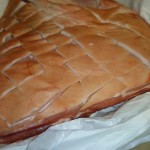
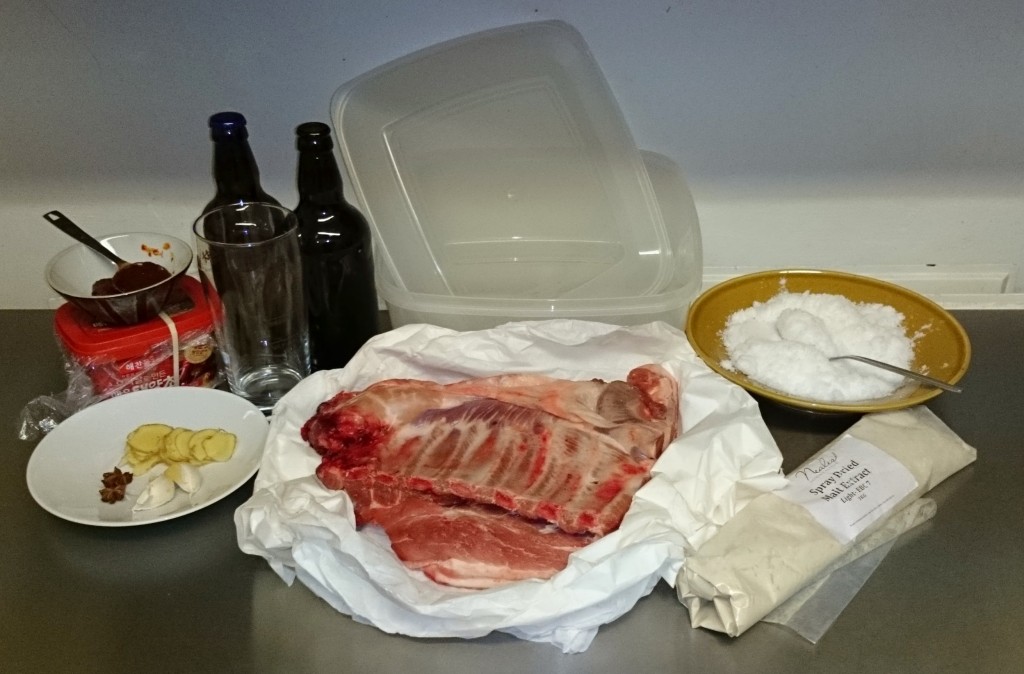

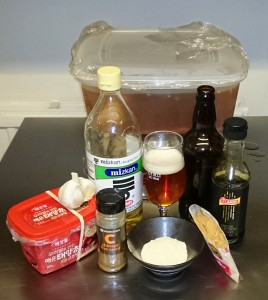

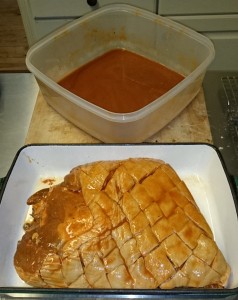

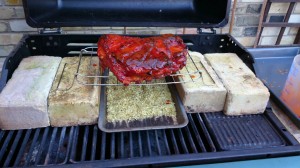

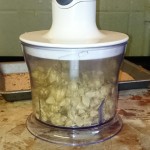







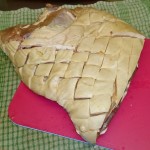
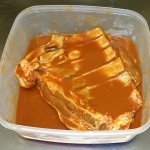






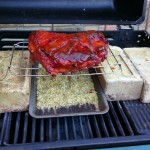




Pingback: Roast Lamb with Porter Gravy | ALE.is.GooD
Pingback: Lunch Log: Week 107 | ColourBox
Nice one. I’ll have to give this a go.